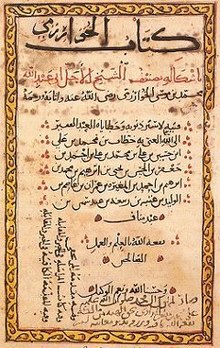Sejarah matematika: Perbedaan antara revisi
rintisan |
(Tidak ada perbedaan)
|
Revisi per 1 Maret 2010 02.59

Cabang pengkajian yang dikenal sebagai sejarah matematika adalah penyelidikan terhadap asal mula penemuan di dalam matematika dan sedikit perluasannya, penyelidikan terhadap metode dan notasi matematika di masa silam.
Sebelum zaman modern dan penyebaran ilmu pengetahuan ke seluruh dunia, contoh-contoh tertulis dari pengembangan matematika telah mengalami kemilau hanya di beberapa tempat. Tulisan matematika terkuno yang telah ditemukan adalah Plimpton 322 (matematika Babilonia sekitar 1900 SM),[1] Lembaran Matematika Rhind (Matematika Mesir sekitar 2000-1800 SM)[2] dan Lembaran Matematika Moskwa (matematika Mesir sekitar 1890 SM). Semua tulisan itu membahas teorema yang umum dikenal sebagai teorema Pythagoras, yang tampaknya menjadi pengembangan matematika tertua dan paling tersebar luas setelah aritmetika dasar dan geometri.
Matematika prasejarah
Timur Dekat Kuno
Mesopotamia
Mesir
Matematika Yunani
Matematika Cina
Matematika India
Matematika Eropa Pertengahan
Zaman Pertengahan Dini
Kelahiran kembali
The fourteenth century saw the development of new mathematical concepts to investigate a wide range of problems.[3] One important contribution was development of mathematics of local motion.
Thomas Bradwardine proposed that speed (V) increases in arithmetic proportion as the ratio of force (F) to resistance (R) increases in geometric proportion. Bradwardine expressed this by a series of specific examples, but although the logarithm had not yet been conceived, we can express his conclusion anachronistically by writing: V = log (F/R).[4] Bradwardine's analysis is an example of transferring a mathematical technique used by al-Kindi and Arnald of Villanova to quantify the nature of compound medicines to a different physical problem.[5]
One of the 14th-century Oxford Calculators, William Heytesbury, lacking differential calculus and the concept of limits, proposed to measure instantaneous speed "by the path that would be described by [a body] if... it were moved uniformly at the same degree of speed with which it is moved in that given instant".[6]
Heytesbury and others mathematically determined the distance covered by a body undergoing uniformly accelerated motion (today solved by integration), stating that "a moving body uniformly acquiring or losing that increment [of speed] will traverse in some given time a [distance] completely equal to that which it would traverse if it were moving continuously through the same time with the mean degree [of speed]".[7]
Nicole Oresme at the University of Paris and the Italian Giovanni di Casali independently provided graphical demonstrations of this relationship, asserting that the area under the line depicting the constant acceleration, represented the total distance traveled.[8] In a later mathematical commentary on Euclid's Elements, Oresme made a more detailed general analysis in which he demonstrated that a body will acquire in each successive increment of time an increment of any quality that increases as the odd numbers. Since Euclid had demonstrated the sum of the odd numbers are the square numbers, the total quality acquired by the body increases as the square of the time.[9] -->
Matematika Eropa modern dini
Abad ke-17
Abad ke-18
Abad ke-19
Abad ke-20
Abad ke-21
Lihat pula
Referensi
- ^ J. Friberg, "Methods and traditions of Babylonian mathematics. Plimpton 322, Pythagorean triples, and the Babylonian triangle parameter equations", Historia Mathematica, 8, 1981, pp. 277—318.
- ^ O. Neugebauer, "The Exact Sciences in Antiquity", Chap. IV "Egyptian Mathematics and Astronomy", 2nd ed., Dover, New York, 1969, pp. 71—96.
- ^ Grant, Edward and John E. Murdoch (1987), eds., Mathematics and Its Applications to Science and Natural Philosophy in the Middle Ages, (Cambridge: Cambridge University Press) ISBN 0-521-32260-X.
- ^ Clagett, Marshall (1961) The Science of Mechanics in the Middle Ages, (Madison: University of Wisconsin Press), pp. 421–40.
- ^ Murdoch, John E. (1969) "Mathesis in Philosophiam Scholasticam Introducta: The Rise and Development of the Application of Mathematics in Fourteenth Century Philosophy and Theology", in Arts libéraux et philosophie au Moyen Âge (Montréal: Institut d'Études Médiévales), at pp. 224–27.
- ^ Clagett, Marshall (1961) The Science of Mechanics in the Middle Ages, (Madison: University of Wisconsin Press), pp. 210, 214–15, 236.
- ^ Clagett, Marshall (1961) The Science of Mechanics in the Middle Ages, (Madison: University of Wisconsin Press), p. 284.
- ^ Clagett, Marshall (1961) The Science of Mechanics in the Middle Ages, (Madison: University of Wisconsin Press), pp. 332–45, 382–91.
- ^ Nicole Oresme, "Questions on the Geometry of Euclid" Q. 14, pp. 560–65, in Marshall Clagett, ed., Nicole Oresme and the Medieval Geometry of Qualities and Motions, (Madison: University of Wisconsin Press, 1968).
Bacaan lanjutan
Pranala luar
Jurnal
- Convergence, Majalah Sejarah Matematika online yang dikelola oleh Mathematical Association of America
